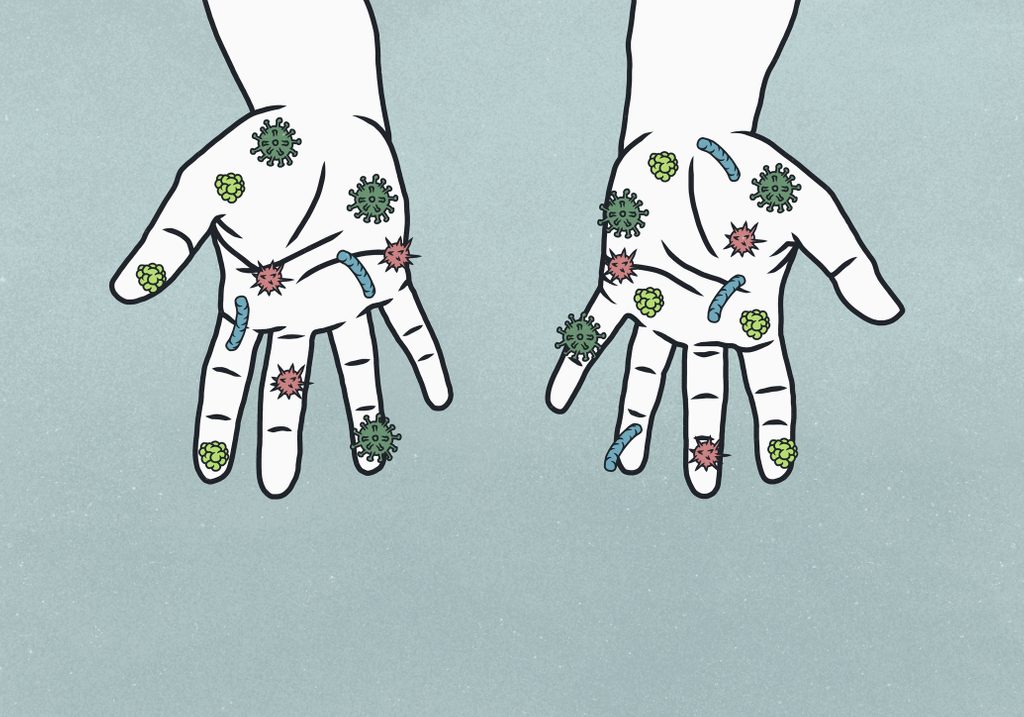
What happens after you wash your hands
Germs are on everyone’s mind these days, thanks to the coronavirus pandemic. How do germs come into our homes? How long can they live on surfaces? And, most importantly, how do we get rid of them? “A really clean home environment is imperative for keeping your family members healthy during cold and flu seasons, including this current outbreak,” says Mary Gagliardi, cleaning expert and senior scientist at Clorox. “Cleaning can also help you feel less stressed and improve your mental health during this time.”
Her number one recommendation for virus and bacteria control echoes that of the U.S. Centers for Disease Control and Prevention (CDC). “Of course washing hands, for 20 seconds, with soap and water is the first step in keeping people healthy and homes clean,” she says. “But a lot of people don’t think about what happens next—have you considered what you use after you do the handwashing?”
Hand towels, it turns out, are one of several surprising breeding grounds for germs that can make you sick, including coronaviruses, she says. “A frequently used towel should be swapped for a clean one every day and then washed with a disinfectant, like bleach,” she says.
Here’s how to find out what else is secretly harboring bacteria and viruses in your home and how to clean those hot spots.
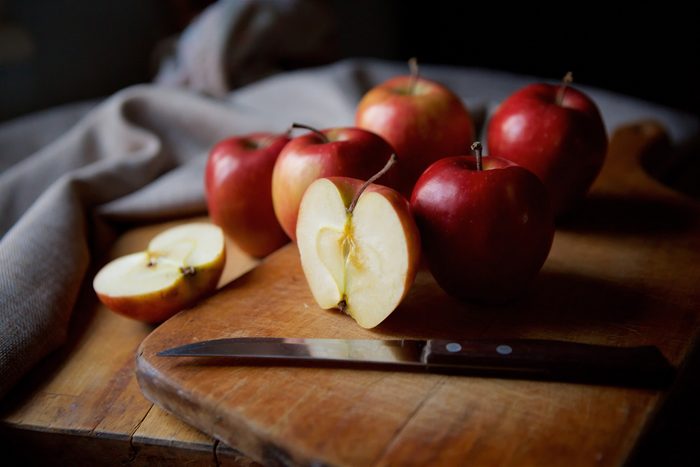
Your cutting board
The average cutting board has 200 times more fecal bacteria than a toilet seat, says Charles Gerba, PhD, a microbiologist at the University of Arizona and author of one of the first studies to measure bacterial contamination of common household objects. A big culprit: raw meat, since many fecal bacteria originate in animals’ internal organs. So, the last chicken cutlet you diced? The tiny grooves your knife left in the cutting board are prime real estate for germs to get cozy.
Clean it: Plastic cutting boards are easier to sterilize than wooden ones and you can clean cutting boards by putting them through the sanitize cycle on your dishwasher or washing them with liquid dish detergent and water, followed by a soak in a solution of two teaspoons of bleach and a gallon of water, Gagliardi says. Check out this A-Z guide to cleaning during coronavirus.
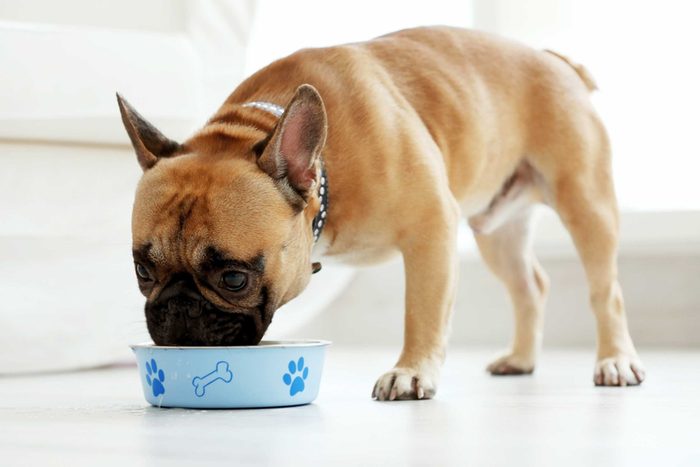
Your pet’s food bowl
One of the home’s dirtiest surfaces could be your pet’s trusty kibble dish, according to a study published by NSF International, a non-profit that tests products and sets international health standards. If your dog licks a toilet seat, he’s picking up about 295 bacteria per square inch. But if he licks the inside rim of his unclean dish, he just gobbled up 2,110 bacteria per square inch—and what dog licks just one inch?
Clean it: To keep pets healthy, wash all food bowls after every meal with hot water and soap, Gagliardi says. If you don’t, bacteria will multiply on the leftover residue of your pet’s slobber and food bits, a little like if you used the same fork every day without washing it.
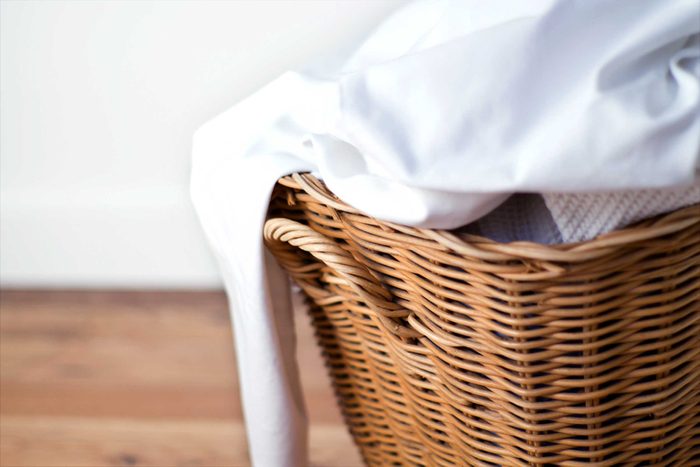
Your clean laundry
A load of underwear will transfer at least 100 million E. coli bacteria—the culprit behind diarrhea—to the washing machine, which becomes a breeding ground that can contaminate other clothing, according to a study published in Frontiers in Microbiology. With a front-loading machine, it’s worse; water settles at the bottom and creates the moist environment bacteria loves. Your toilet seat, on the other hand, is too dry to support a very large bacterial population.
Clean it: The CDC recommends disinfecting your machine by cleaning your washer with bleach at least once a month, adding that you should make sure to disinfect clothing hampers as well. To avoid spreading bacteria, wash underwear separately with hot water and a color-safe bleach replacement.

Your smartphone or tablet
Your phone is 10 times dirtier than a toilet seat, Gerba says. “Cellphones pick up germs all the time and I see people talk on their phone on toilets,” he says. The issue? While toilets tend to get cleaned frequently, because people associate the bathroom with germs, cellphones and other commonly handled objects, like remote controls and phones, are often left out of the cleaning routine, he explains.
Clean it: Reduce your exposure to germs by cleaning your electronic screens with screen wipes or a damp, soft cloth—and leaving them out of the bathroom in the first place, he says.
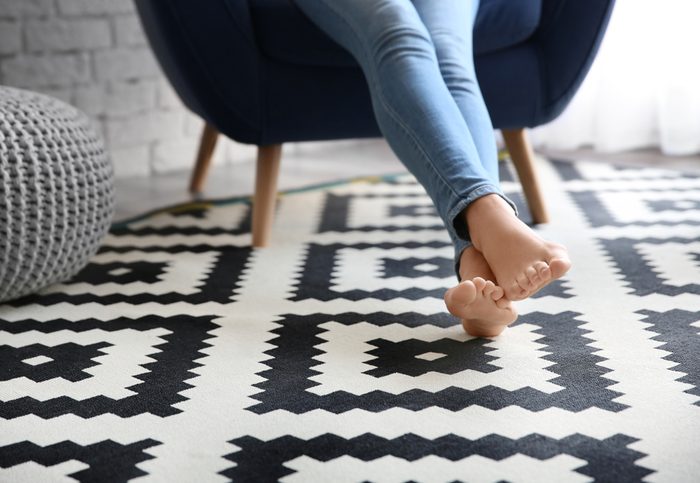
Your carpet
Fun fact: Bacteria love munching on dead skin cells. Considering that the average person sheds about 1.5 million every hour, that turns your rugs into a fine dining experience when you add food particles, pet dander, pollen, and other bits. About 200,000 bacteria live in each square inch of carpet (nearly 700 times more than on your toilet seat), including E. coli, staphylococcus, and salmonella, according to Philip M. Tierno, PhD, a microbiologist and immunologist at New York University Langone Medical Center and the author of The Secret Life of Germs.
Clean it: Since your vacuum cleaner can’t reach to the bottom of the carpet, hire a company to do a deep steam-cleaning at least once a year, Tierno says. Use machine-washable area rugs wherever possible and wash them on the sanitize cycle. Learn what the dirtiest items in hotel rooms are.
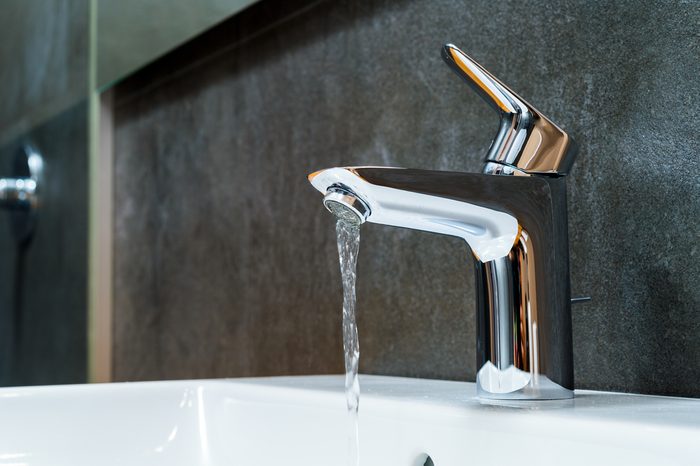
Your faucet handles
Your bathroom faucet handle can have 21 times the bacteria of your toilet seat. Even worse—your kitchen faucet handles and sink can harbor 44 times the bacteria of your toilet seat, according to a study published in Applied and Environmental Microbiology. Researchers found that because cleaning products often don’t get down into pipes, drug-resistant bacteria like E. coli can spread from the pipes to your sink and hands. In addition, the NSF found that faucet handles in both the kitchen and bath contained coliform bacteria as well as yeast and/or mold.
Clean it: The NSF recommends cleaning daily with disinfecting cleaner, bleach solution or disinfecting wipes. Check out these EPA-approved coronavirus cleansers.

Your computer keyboard
Clicking away at your computer in between bites of lunch may have led to the last “office bug” you picked up as they can become seriously contaminated with fecal matter, according to a study published in the International Journal of Environmental Research and Public Health. While they aren’t the dirtiest thing in your home, computers can harbor up to five times the germs of a toilet seat, Gerba says.
Clean it: Wash hands, and surfaces, often. The study found that simple wiping with antibacterial wet wipe led to a significant reduction of microbial contamination. As if all that weren’t enough, here are some more reasons you should definitely clean your computer keyboard.
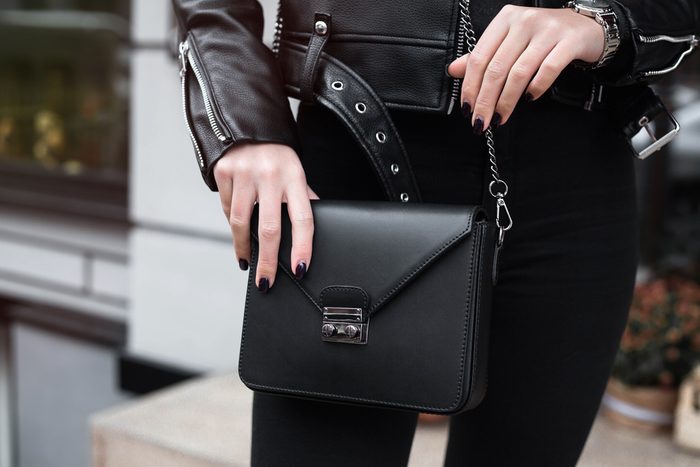
Your purse
A good handbag goes with everything—including germs. Ninety-five percent of purses and handbags carried by both men and women showed contamination by fecal matter, making the average handbag dirtier than an office toilet seat, according to a study published in Advanced Biomedical Research. And the more used the handbag, the dirtier it was with handles showing the most bacteria.
Clean it: Keep your bags off the ground, and regularly wash cloth bags when possible. Use disinfectant wipes for plastic or leather bags, the NSF says.
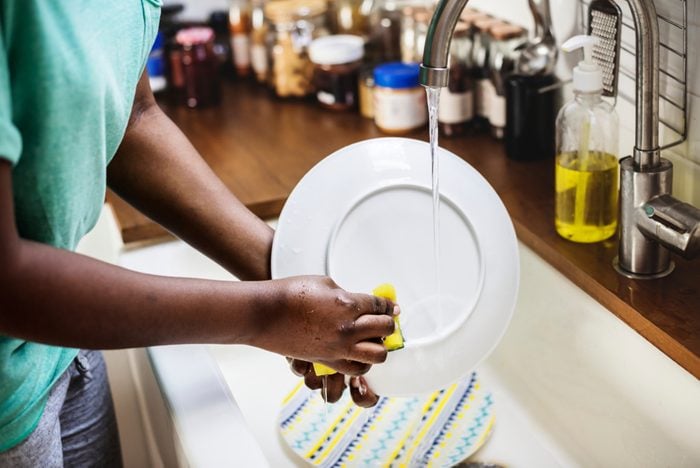
Your kitchen cloth or sponge
Not only are sponges dirtier than your toilet seat, but they’re dirtier than any other item in your house. When researchers investigated 14 used kitchen sponges, they found an insane 45 billion microbes per square centimeter, according to the results in Nature. Dishcloths and sponges harbor the largest amount of E. coli and other fecal bacteria in the average home, mostly because they aren’t replaced as often as they should.
Clean it: Place wet sponges in the microwave for two minutes once per day and replace often, the NSF says. Or replace your sponges with dishcloths, towels, and rags as these items can be sanitized by washing in your washer’s sanitizing cycle or with bleach, they say.

Your TV remote
It may surprise you, but your channel changer is surprisingly germy, Tierno says. Anything that’s been on your hands before you started surfing collects on your remote. Not to mention, your remote collects dust sitting on your couch, gets sat on, and may even have crumbs on it, if you like to eat in front of the TV. Grime can get stuck in the nooks and crannies between the buttons, so cleaning it can be a challenge.
Clean it: You can use disinfectant wipes to do a quick clean but Tierno suggests using a plastic disposable remote sleeve that can be changed often. Here are 10 more germ-spreading habits you should give up.

Gas pumps
Gas pumps are one of those things you touch without thinking about it yet when you consider the number of people who touch them (hundreds) and the number of times they get cleaned (likely zero), it shouldn’t surprise you that they are germ factories. Seventy-one percent of gas pumps contained some type of bacteria, according to Gerba’s research.
Clean it: If you don’t want to wipe down the pump before you use it, definitely keep hand sanitizer in your car so that you can bust any germs you may have picked up while filling up, he says.

Elevator buttons
While you’re getting a ride to your desired floor, germs might be hitching a ride on your hands. Elevator buttons in public spaces like office buildings and hospitals could be harboring more germs than toilet seats, according to a study published in Open Medicine. And this was true in hospitals, which are probably getting cleaned more often than the ones in your local buildings.
Clean it: Maybe you don’t want to stand around your office building and wipe down the elevator buttons, and that’s fair. But you’ll probably want to wash, or at least sanitize, your hands once you’ve reached your floor, Gagliardi says. (These common house cleaning mistakes can actually make your home dirtier.)
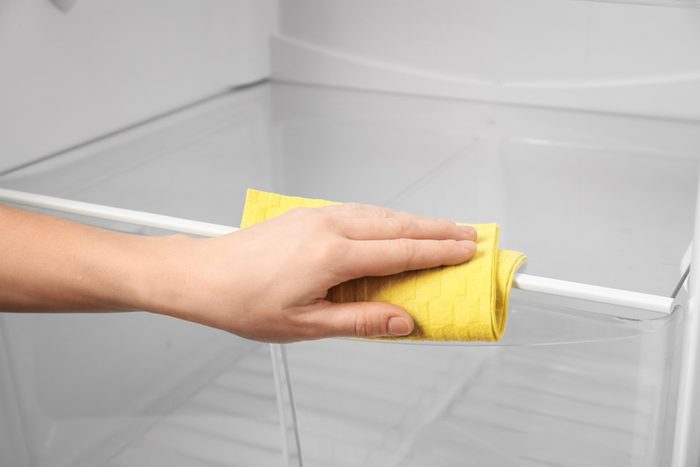
Fridge drawers
A study from the NSF found that refrigerator vegetable and meat compartments were the top two spots in the kitchen with the most disease-causing microorganisms. It makes sense—any unwrapped veggies or escaped meat juices could leave behind dangerous germs.
Clean it: Empty your fridge drawers, then pull them out of your fridge. Give them a good scrub with warm, soapy water before returning them (and your food) to their slots, Gagliardi says.
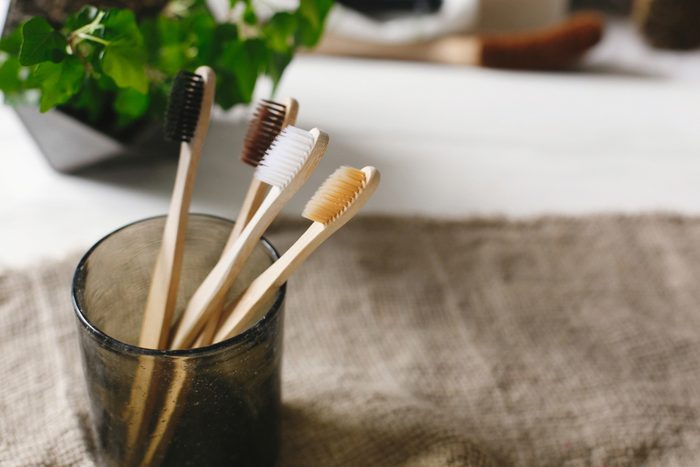
Toothbrush holders
Hopefully, you’re replacing your toothbrush every three to four months, but when was the last time you cleaned out its holder? Fair warning: It’s probably filled with toothpaste gunk that dripped down after you brushed. The NSF study found that toothbrush holders were the dirtiest item in the bathroom. About 27 percent of toothbrush holders showed signs of coliform, compared to 5 percent of toilet seats.
Clean it: The NSF advises placing the toothbrush holder in a sanitizing dishwasher and washing once or twice a week. If yours isn’t dishwasher safe, hand wash with hot soapy water, rinse and then wipe with disinfecting wipe once or twice a week.

Coffee reservoir
You probably clean the coffee pot, but you’ll want to give the whole machine a deep clean every once in a while. NSF findings show that coffee reservoirs where you pour water are even dirtier than toilet seats and toilet handles. In fact, it made the top five germiest places in the home. Given the dark, damp location, it’s not surprising that it is a prime location for bacteria, mold, and mildew to grow.
Clean it: The NSF says to follow the manufacturer’s recommended cleaning instructions. Usually this means cleaning by adding up to four cups of undiluted vinegar to the reservoir, letting it stand for 30 minutes and then running the vinegar through the unit. This is followed by running two to three cycles of fresh water through the unit until the vinegar odor is gone. Most manufacturers recommend cleaning every 40-80 brew cycles or at least monthly.
Don’t miss the 14 most germ-ridden spots in your own bedroom.